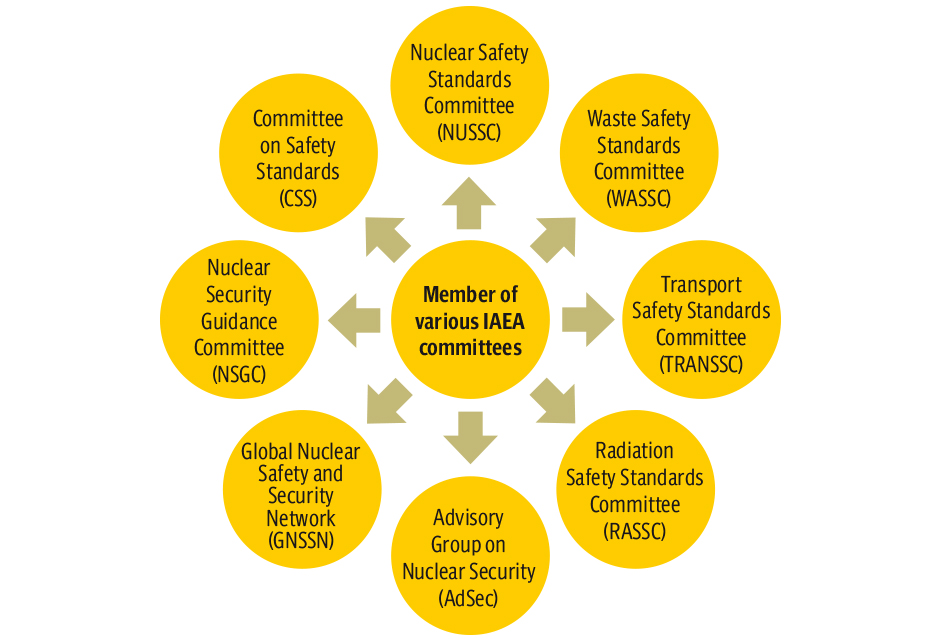Titled ÔÇÿPakistanÔÇÖs Nuclear Security RegimeÔÇÖ, the booklet released alongside the International Atomic Energy AgencyÔÇÖs (IAEA) third International Conference on Nuclear Security (ICONS) aims to demonstrate the countryÔÇÖs ÔÇ£commitment and contribution to the global objectives of nuclear security.ÔÇØ
ÔÇ£This step is part of Pakistan's practice to share information on the measures taken to further strengthen nuclear security and to demonstrate the high-level attention that nuclear security continues to receive in Pakistan,ÔÇØ the Foreign Office said in a statement. It added that the document was being distributed among all ICONS participants.
International atomic watchdog commends nuclear security measures taken by Pakistan
The booklet, a copy of which The Express Tribune was able to obtain, outlines PakistanÔÇÖs nuclear safety regime in the form of three ÔÇÿpillarsÔÇÖ, namely legislative and regulatory framework, state institutions and organisations, and the security systems and measures.
Laying out the first of these, the document explains that the legislative and regulatory framework includes ÔÇ£establishing independent regulatory bodies with adequate legal authority to fulfill their assigned nuclear security responsibilities,ÔÇØ such as the National Command Authority (NCA), Pakistan Atomic Energy Commission (PAEC), Pakistan Nuclear Regulatory Authority (PNRA) and Strategic Export Control Division (SECDIV).
In order to cover the entire spectrum of activities, the NCA Act was promulgated in 2010 [with] wide jurisdiction and adequate legal authority to regulate activities of various entities working within its domain, the booklet states. It also highlights legal frameworks that existed prior to the NCA Act, such as the PAEC and PNRA ordinances, and the Strategic Export Control Act, which strengthens export controls on sensitive and dual use goods/technologies related to nuclear and biological weapons and their means of delivery.
To prevent unauthorised removal of nuclear material and curb the risk of sabotage, PNRA promulgated ÔÇÿRegulations on Physical Protection of Nuclear Material and Nuclear Installations ÔÇö (PAK/925)ÔÇÖ last April, the booklet notes. ÔÇ£This regulation takes into consideration IAEAÔÇÖs Nuclear Security Recommendations on Physical Protection of Nuclear Material and Nuclear Facilities and the obligations of Convention on the Physical Protection of Nuclear Material.ÔÇØ
Foolproof nuclear security mechanisms in place: FO
Outlining the countryÔÇÖs nuclear security architecture, the document emphasises a ÔÇÿmulti-layered defenceÔÇÖ as its cornerstone. ÔÇ£A concept of 5Ds ÔÇô deter, detect, delay, defend and destroy ÔÇô is followed to respond to these threats,ÔÇØ it states.
For physical protection, the booklet explains that Pakistan has deployed modern technological solutions, such as intrusion detection systems, access control systems, delay barriers and search systems and a central alarm station. ÔÇ£In addition, land-based and sea-borne response capabilities of response forces have also been strengthened,ÔÇØ it adds.
The booklet highlights the ÔÇÿeffectiveÔÇÖ National Nuclear Detection Architecture (NNDA) to regulate authorised imports and exports and prevent illicit trafficking of radioactive materials. ÔÇ£Designated entry/ exit points have been equipped with hand held radiation detection equipment as well as radiation portal monitors (RPMs),ÔÇØ it states.
It also reveals that a Nuclear Emergency Management System (NEMS) has been put in place to respond and manage nuclear or radiological emergencies. ÔÇ£Under this system, technical expertise will be provided by PAEC and PNRA; administrative coordination would be done by National Disaster Management Authority (NDMA); while NCA would offer support to address nuclear or radiological emergency.ÔÇØ
To build capacity and human resources for nuclear security, the country has also established the Pakistan Centre of Excellence for Nuclear Security, National Institute of Safety and Security and the Pakistan Institute of Engineering and Applied Sciences, it points out.
Pakistan conducts successful training launch of Ghaznavi ballistic missile
Finally, the booklet also highlights the international instruments the country adheres to in order to ensure a robust nuclear security architecture, such as the IAEA Code of Conduct, UN Security Council Resolution 1540, Nuclear Security Summit Process, Nuclear Security Contact Group and Global Initiative to Combat Nuclear Terrorism.
ÔÇ£In the months and years ahead, Pakistan looks forward to working closely with IAEA and its member states to ensure nuclear security continues to receive high level attention, appropriate salience in the agencyÔÇÖs work, unfailing vigilance at the national level and robust international cooperation,ÔÇØ it concludes.
 DESIGN BY MOHSIN ALAM
DESIGN BY MOHSIN ALAMIn the foreword he wrote for it, Foreign Secretary Sohail Mahmood notes that the booklet ÔÇ£reflected PakistanÔÇÖs commitment towards ensuring a comprehensive national nuclear security regime.ÔÇØ
ÔÇ£Nuclear security is a state responsibility and it receives the highest level of attention in Pakistan in accordance with our domestic and international obligations,ÔÇØ he writes, adding that the regime is based on ÔÇ£extensive legislative and regulatory frameworkÔÇØ and backed by ÔÇ£strong institutions and organisationsÔÇØ.
Speaking to The Express Tribune, some of PakistanÔÇÖs pre-eminent defence experts noted that the countryÔÇÖs spotless nuclear safety record attested to the robustness of its security regime.
ÔÇ£We have a very effective command and control structure and our nuclear workforce operates under a very strict and secure framework,ÔÇØ said Maj Gen (retd) Inamul Haque. ÔÇ£The mere fact that there has been no nuclear incident ÔÇô no accident or alert, no theft of nuclear material or kidnapping of any of our nuclear programme personnel ÔÇô even though we were in a state of war for 15 years is a testament.ÔÇØ
ÔÇ£Our nuclear safety record proves itself to be very credible and speaks for itself. By and large, this credibility has only enhanced with time and the credit for that goes to both our nuclear scientists and nuclear managers,ÔÇØ added Lt-Gen (retd) Talat Masood. ÔÇ£We do not take anything for granted and the custodians of our nuclear assets do not rest on past laurels. The safety of our nuclear assets continues to be a primary focus for our civil and military authorities,ÔÇØ he stressed.
Speaking about concerns the global community voices every now and then regarding PakistanÔÇÖs nuclear programme, both analysts concurred it was driven by some ÔÇÿmaliceÔÇÖ.
ÔÇ£When we speak of nuclear concerns, there are two different camps in the world,ÔÇØ said Talat. ÔÇ£The first of these is concerned about nuclear proliferation as a whole and is opposed to the very existence of nuclear weapons no matter which countryÔÇÖs arsenal they are part of. The concerns of this camp as such are generalised and are a different matter entirely.ÔÇØ
ÔÇ£The second camp that is focused on particular nations only, at least in PakistanÔÇÖs case, is motivated by malicious reasons,ÔÇØ he added.
According to Inam, concerns about PakistanÔÇÖs nuclear programme mainly stemmed from the ÔÇÿA Q Khan episodeÔÇÖ. ÔÇ£That incident continues to colour world opinion about our nuclear safety but these repeatedly voiced concerns are by now just propaganda,ÔÇØ he said. ÔÇ£To counter that, we have to keep repeating our message and that is where this booklet comes in.ÔÇØ
The booklet is the second version of ÔÇÿPakistan's Nuclear Security RegimeÔÇÖ, which was first published in the form of a brochure on the sidelines of the previous ICONS in 2016.


1729662874-0/One-Direction-(1)1729662874-0-165x106.webp)






1726722687-0/Express-Tribune-Web-(9)1726722687-0-270x192.webp)
1732103737-0/Copy-of-Untitled-(55)1732103737-0-270x192.webp)






COMMENTS
Comments are moderated and generally will be posted if they are on-topic and not abusive.
For more information, please see our Comments FAQ